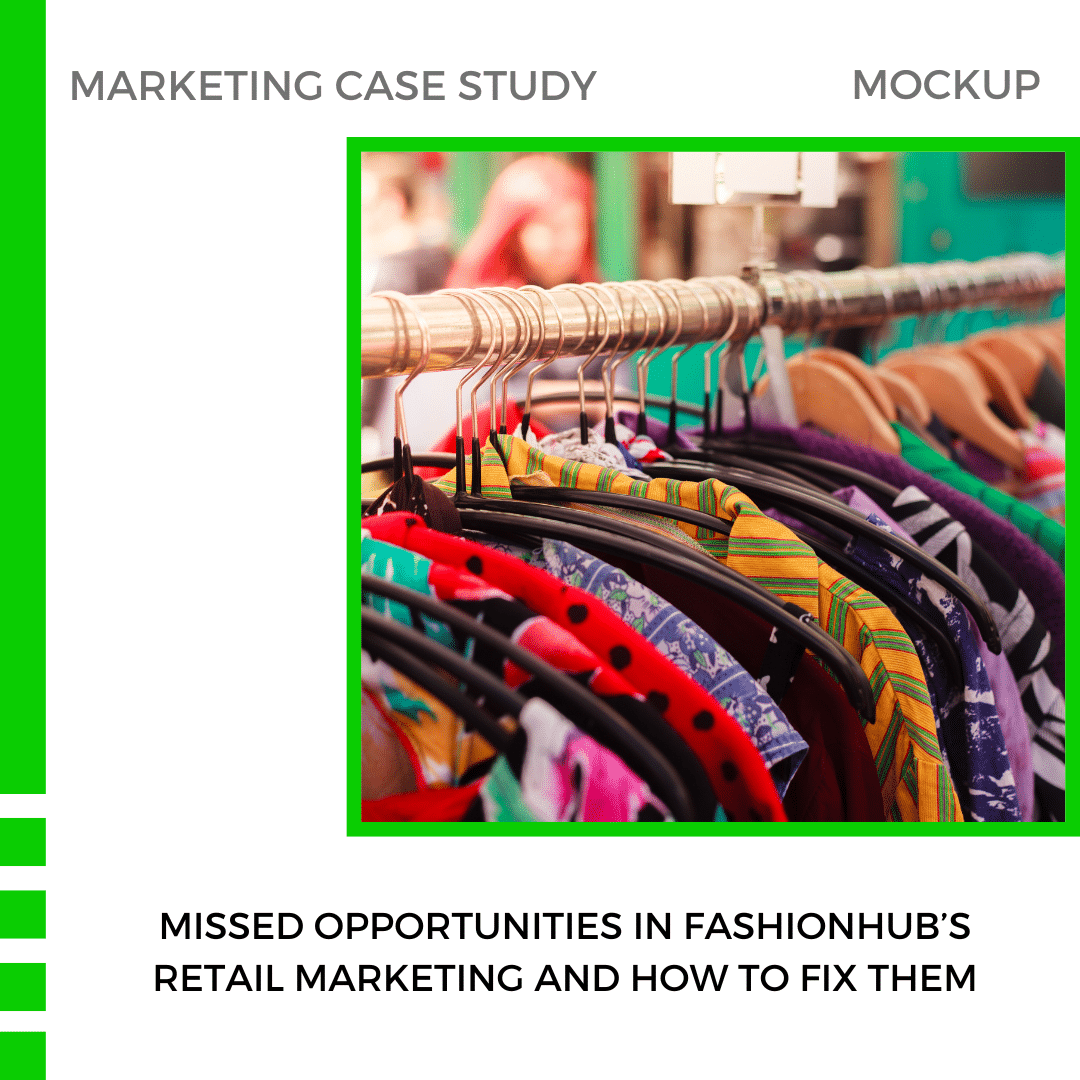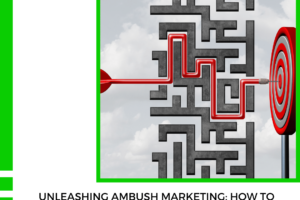
Missed Opportunities in FashionHub’s Retail Marketing and How to Fix Them
Introduction
In today’s competitive retail landscape, effective retail marketing is essential for driving sales, attracting customers, and fostering brand loyalty. This case study centres on the fictional mid-sized retailer FashionHub, which specializes in affordable, trendy apparel for men and women. FashionHub employs a multichannel retail marketing strategy, including in-store promotions, online marketing, loyalty programs, social media engagement, and visual merchandising. By analyzing these efforts, students will evaluate the effectiveness of FashionHub’s marketing approach and propose recommendations for improvements to optimize the customer experience and sales performance.
Objectives
- Understand key retail marketing strategies and their impact on consumer behaviour.
- Analyze real-world applications of retail marketing strategies within FashionHub’s operations.
- Evaluate the effectiveness of FashionHub’s marketing efforts across various channels.
- Develop actionable recommendations to optimize FashionHub’s retail marketing strategies.
Background Information
Key Concepts
- Retail Marketing: Engaging customers directly through in-store, digital, and other channels to promote and sell products.
- Customer Experience: Customers’ overall perception based on all their interactions with a brand.
- Omnichannel Marketing: An integrated marketing approach that ensures customers have a seamless experience across multiple channels.
- Loyalty Programs: Strategies focused on rewarding repeat customers to foster brand loyalty.
- Visual Merchandising: Creating attractive in-store displays to engage customers and influence buying behaviour.
The Company: FashionHub
Founded in 2015, FashionHub is a growing retailer offering a range of affordable, stylish clothing options. Its operations include physical stores and an e-commerce website designed to provide customers with a seamless and enjoyable shopping experience.
FashionHub’s Retail Marketing Strategies
Marketing Channels and Tactics Used
- In-Store Promotions
- Seasonal sales and discounts to increase foot traffic.
- Flash sales and events are designed to create urgency and excitement.
- Online Marketing
- E-commerce website with a user-friendly design and mobile compatibility.
- Email campaigns featuring personalized offers and updates.
- Social Media Marketing
- Active presence on Instagram, Facebook, and Pinterest to connect with customers.
- Engaging posts, including style tips, customer testimonials, and influencer collaborations.
- Loyalty Programs
- Points-based loyalty programs with rewards such as discounts and exclusive early access.
- Referral program offering rewards for customers who bring in new buyers.
- Visual Merchandising
- Attractive window displays designed to draw in passersby.
- Well-organized in-store layouts aimed at enhancing customer shopping experiences.
- Customer Service Initiatives
- Training staff to deliver exceptional customer service.
- Hassle-free return and exchange policy to enhance the customer experience.
Case Study Analysis
Task 1: Assess the Effectiveness of In-Store Promotions
- Sales Data Analysis
- Examine the impact of seasonal sales on overall sales metrics.
- Measure the effectiveness of in-store promotions in driving conversions.
- Customer Feedback
- Analyze customer feedback on in-store promotional events.
- Identify areas for improving the appeal and execution of in-store promotions.
Task 2: Evaluate Online Marketing Efforts
- Website Performance
- Evaluate user engagement metrics, including website traffic, bounce, and conversion rates.
- Assess the e-commerce platform’s mobile optimization to enhance user experience.
- Email Marketing
- Review email campaign open and click-through rates.
- Assess the impact of personalized offers on customer engagement and retention.
Task 3: Analyze Social Media Marketing
- Engagement Metrics
- Evaluate the effectiveness of FashionHub’s social media content.
- Identify high-engagement content types, such as customer reviews or style guides.
- Campaign Analysis
- Assess the success of specific campaigns in driving brand awareness and sales.
- Evaluate the influence of influencers and user-generated content on customer perceptions.
Task 4: Review Loyalty Programs
- Participation and Redemption Rates
- Measure loyalty program participation and reward redemption rates.
- Evaluate the impact of the loyalty program on customer retention and repeat business.
- Customer Retention
- Assess customer retention rates for loyalty members.
- Identify opportunities to enhance the value of loyalty rewards.
Task 5: Assess Visual Merchandising
- Store Layout and Display Effectiveness
- Examine the influence of visual merchandising on customer shopping behaviour.
- Assess the effectiveness of window displays in capturing customer interest.
- Customer Experience
- Evaluate customer feedback on store layout and product displays.
- Identify areas for improvement in in-store layout and visual appeal.
Proposed Recommendations for Retail Marketing Optimization
Enhancing In-Store Promotions
- Incentivize Repeat Visits: Offer exclusive in-store discounts for loyalty members during promotional events.
- Customer-Centric Flash Sales: Customize flash sales based on purchasing trends to maximize appeal.
Optimizing Online Marketing
- Website Enhancements: Improve load speeds and mobile responsiveness for a better user experience. Learn more about e-commerce optimization here.
- Email Personalization: Leverage AI to generate product recommendations and tailor offers to specific customer segments.
Boosting Social Media Engagement
- User-Generated Content: Encourage customers to share photos with FashionHub products by offering incentives.
- Influencer Collaborations: Focus on influencers within niche fashion segments who resonate with FashionHub’s target audience.
Improving Loyalty Programs
- Point Multipliers: Introduce point multipliers for purchases made during promotional periods.
- Tiered Loyalty Rewards: Create additional tiers within the loyalty program to further incentivize repeat purchases.
Enhancing Visual Merchandising
- Interactive Displays: Use augmented reality in-store displays to provide an immersive experience, letting customers visualize products in real-world settings.
- Thematic Displays: Rotate displays seasonally to align with current fashion trends, creating a refreshed experience for repeat customers.
Improving Customer Service
- Staff Training: Invest in ongoing training to enhance customer interaction skills and maintain a high-quality service experience.
- Return Policy Communication: Improve communication about the return and exchange policies to build customer trust.
Financial and Market Data for Analysis
Sales Data
| Period | Total Sales | In-Store Sales | Online Sales |
|---|---|---|---|
| Q1 2023 | $500,000 | $300,000 | $200,000 |
| Q2 2023 | $600,000 | $350,000 | $250,000 |
| Q3 2023 | $700,000 | $400,000 | $300,000 |
| Q4 2023 | $800,000 | $450,000 | $350,000 |
Website Performance Metrics
| Metric | Value |
|---|---|
| Monthly Visitors | 100,000 |
| Bounce Rate | 40% |
| Conversion Rate | 5% |
Social Media Metrics
| Platform | Followers | Engagement Rate |
|---|---|---|
| 50,000 | 7% | |
| 40,000 | 5% | |
| 30,000 | 6% |
Email Marketing Metrics
| Metric | Value |
|---|---|
| Open Rate | 20% |
| Click-Through Rate | 10% |
| Conversion Rate | 4% |
Loyalty Program Metrics
| Metric | Value |
|---|---|
| Participation Rate | 25% |
| Redemption Rate | 15% |
Customer Feedback
| Aspect | Positive Feedback | Negative Feedback |
|---|---|---|
| Product Quality | 85% | 15% |
| Pricing | 70% | 30% |
| Availability | 80% | 20% |
| Customer Service | 90% | 10% |
| Store Layout | 75% | 25% |
Possible Solution
FashionHub’s retail marketing success can be achieved by integrating omnichannel approaches and personalized customer experiences. Leveraging customer insights, FashionHub should refine its loyalty programs and digital marketing to maintain relevance in an evolving market. Learn more about retail marketing trends at the Retail Industry Leaders Association.
Conclusion
Retail marketing strategies are foundational to creating memorable shopping experiences and establishing brand loyalty. For FashionHub, these strategies across in-store promotions, digital marketing, social media, loyalty programs, and visual merchandising have shown the potential to enhance customer engagement and drive sales. By refining these strategies and implementing innovative solutions, FashionHub can further optimize its retail marketing efforts to meet evolving customer expectations. This analysis and the recommendations provided offer a pathway to stronger brand presence and growth in today’s competitive retail landscape.



